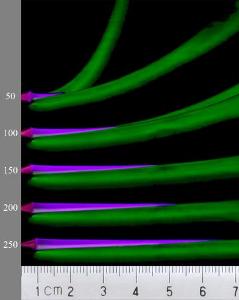Aug 25 2010
College Park, MD (August 24, 2010) -- Because they are portable and easy to operate at ambient temperatures, cold atmospheric pressure plasma jets (APPJs) should find innovative applications in biomedicine, materials science and fabrication industries. Research reported in the Journal of Applied Physics investigates an APPJ that extends from the ground electrode of a circuit.
The researchers studied the mechanism of the jet, which differs from conventional APPJ applications that form at the active electrode.
 Photographs of atmospheric pressure plasma jet and Schlieren photograph of helium gas flow showing obvious interplay of the jet with the carrying gas flow. Numbers at left specify the gas flow rate in liter/hour. Applied voltage: 8 kV
Photographs of atmospheric pressure plasma jet and Schlieren photograph of helium gas flow showing obvious interplay of the jet with the carrying gas flow. Numbers at left specify the gas flow rate in liter/hour. Applied voltage: 8 kV
"The ground electrode jets originate from a charge overflow and are powered by the dielectric barrier discharge between the electrodes," say authors Nan Jiang and Zexian Cao of the Beijing National Laboratory for Condensed Matters in China. "They are therefore isolated from electrical breakdown when the jet approaches an object."
This separation between the jet and active electrode, along with the ability to form a jet at lower voltages than conventional APPJs increases operator safety and opens up biomedical applications that would be dangerous otherwise.
By using narrow, transparent ground electrodes, the researchers found that the overflow jet begins to develop at the inner edge of the ground electrode, and propagates forward in the dielectric via surface microdischarge which, to the surprise of the authors, causes backstreaming of charges. The output characteristics of the jet can be tuned by adjusting the conditions of dielectric barrier discharge between the electrodes and by varying the width of the ground electrode.
"This allows a flexible, miniaturized design since it is the ground electrode that sits at the front part of the device," says Cao. Further research will strive for a detailed understanding of the processes involved in the generation of such plasma jets, for example, the interplay of charged jet with the carrier gas flow, shown in the accompanying illustration.
Source: http://www.aip.org/